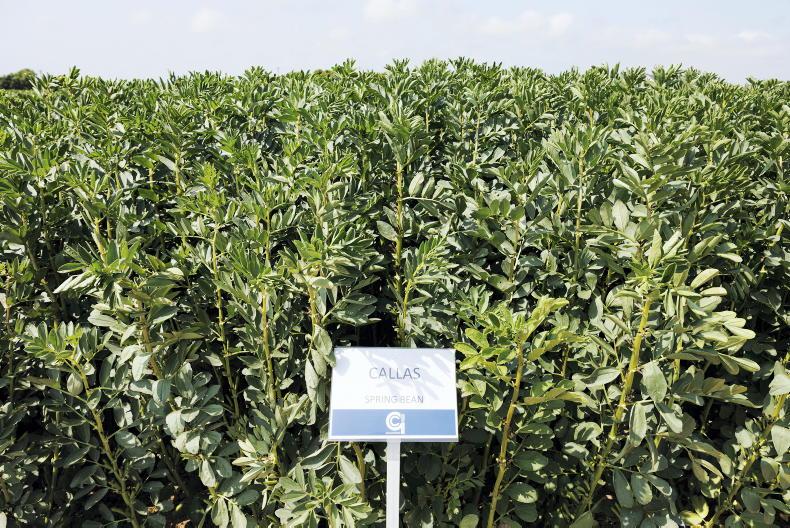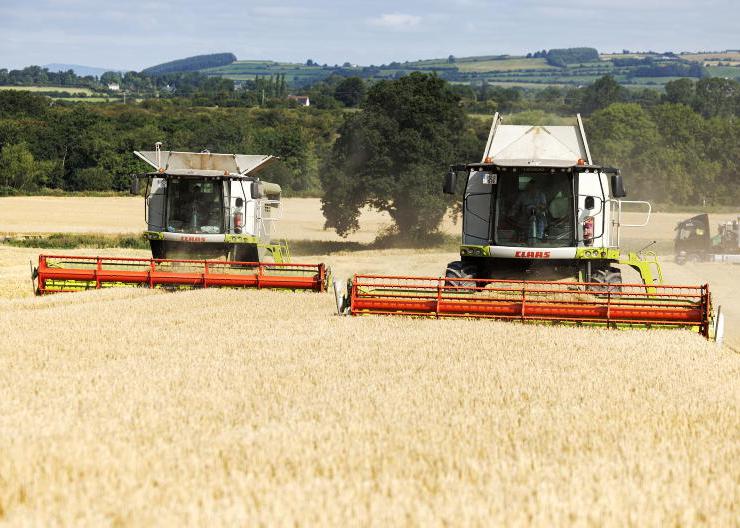The past few weeks have already seen many seminars and conferences, all of which bring something additional or new to how we think and possibly react. This article brings the main points from a recent seminar,organised by Quinns of Baltinglass.
This company is just one of many who are now trying to produce and use significant quantities of native protein and beans in particular.
Acknowledging the poor performance of many crops in 2018 and the possible backlash on acreage, any effort to secure supply will largely hinge around price offers to encourage planting.
Against this background, Quinns offered potential growers within its customer base a guaranteed price of €220/t for green beans up to 22% moisture content, for forward contracts that were signed by the following evening at close of business. The offer was subsequently extended to close of business on Friday of last week.
Delivering
profitable protein
David Shortall of Quinns spoke about profitability from protein crop production and he showed that in recent years, the bean crop was a very useful contributor to farm profit.
David presented numbers based on Teagasc data, which showed higher crop margins from beans than from spring feeding barley at normal yield levels.
This benefit is further increased when the price for the protein crop carries an even bigger premium over barley.
He went on to say that the higher crop margin is only one of the benefits which accrue from having this crop in a rotation.
The crops will also need whatever protein aid support that is available to generate a margin level to make it attractive
Others include spreading the workload in spring and at harvest, broadening the base of herbicides that can be used on land, improving the condition of the soil, producing its own nitrogen and leaving some behind for the following crop etc.
But perhaps the biggest benefit is its capacity to generate higher yield levels in the following crop, an estimated average benefit of 1-1.2 t/ac increase.
David went on to talk about the soya bean exploration work in 2018 and he told the audience that the crop is are certainly not yet field ready for growers. Yield was an issue in 2018 but he believes the potential is about double that experience of 0.6 t/ac, but some combining challenges will need to be sorted out.
The crops will also need whatever protein aid support that is available to generate a margin level to make it attractive.
Work to examine the potential of the crop will continue and David said that he is confident that the crop will ripen and mature every year in our climate, as that would have been a major concern.
Teagasc advisor, Ivan Whitten, emphasised the importance of good husbandry for bean production.
What field to use is possibly the first and among the most important of these decisions.
For beans, soils need to have medium to heavy texture as these have the potential to deliver high yield in most years. Compacted soils must be avoided.
Fertility
Fertility is the next consideration. As with many crops, pH is the primary requirement.
While this is often presented as 6.5 to 6.8 optimum, I would prefer to be targeting bean fields at 6.8 to 7.0 pH where this is possible.
Soil P and K levels are also important with high indices regarded as essential to help deliver high yields.
Ivan pointed to the necessity to put these elements down with the seed at drilling, where soil indices are low but emphasised that this may still not deliver full yield potential on low indices. Index 1 soils might be avoided altogether.
There are many different methods in which beans can be successfully planted but one of the important considerations is to get the seed down to about 10cm or more to help prevent crow damage post planting.
Watch emerging plants for signs of adult weevil damage – notching along the edge of the leaves
This may still happen, especially around emergence stage, but the overall damage from feeding birds is likely to be greater where the seeds can be taken immediately post planting.
Seeding rate is flexible but it should be based around the size of the seed with a target optimum rate of 35-40 seeds per square meter to establish over 30 plants/m2. Watch emerging plants for signs of adult weevil damage – notching along the edge of the leaves.
Where this is present crops should be sprayed with a pyrethroid insecticide to prevent egg laying and subsequent destruction of the nitrogen forming nodules by its larvae.
Weed control is generally based on the application of Nirvana and this can be supplemented post emergence with Basagran if volunteer rape is a problem.
Disease control should begin at the start of flowering, with a follow-up spray three weeks later. This will use Rover plus either Amistar or Folicur or, alternatively, Signum.
Ivan said that there is little benefit in crop desiccation for crop maturity but this can be useful where there are weeds in a crop, as these can take off as the crop senesces.
Soil will come under increased scrutiny
Crop consultant John Geraghty has long shown his passion for soils and at the Quinns seminar he warned growers that many aspects of soils will come under increased scrutiny from officialdom.
While soils are integral to most farming systems, they also naturally fulfil other important functions for the environment.
Soils should enable water percolation, where the passage through the soil to surface and ground water bodies should help to purify the water in a healthy soil.
Soils are also important as a source of biodiversity. Soil that is being fed with organic matter can support literally billions of different organisms, most of which bring other potential benefits to the full system.
Better structure helps crop growth but it also enables water percolation
John said that it seems inevitable that environmental solutions will be pressured onto farmers to help solve challenges like flooding, biodiversity, etc.
However, the solutions to these issues are also likely to give considerable direct benefit to farmers themselves.
Ultimately, this will mean the addition of varying types of organic matter to land to help build biodiversity within the soil’s biological system and this will then add to the natural supply of nutrients as well as helping to improve soil structure.
Better structure helps crop growth but it also enables water percolation, which slows the surface flow that has caused so much severe flooding in recent years. And with more severe weather events predicted, this becomes an increasingly important characteristic.
Acreage: the first
price pressure
Speaking on grain markets, James Nolan of R&H Hall stated all current indications indicate an increasing area of winter grain planted in many parts of the world last autumn.
On top of this, we are likely to see an increased area sown to maize in the US, the world’s biggest producer.
Whether old crop rises or new crop falls will depend on the yield prospects for the crop in the ground
Together these signals point to the likelihood of increased grain production in 2019, with the possibility of pressure on prices.
Against this background James commented on the gap between current prices for old crop grains and the new crops after next year’s harvest.
The gap is big but this will close as the months progress. Whether old crop rises or new crop falls will depend on the yield prospects for the crop in the ground.
Average yields are likely to generate surplus; higher than average yields will inevitably depress prices further.
One of the big challenges in the market, not just in Ireland, is the continuing displacement of barley especially by maize.
This is generating a risk that the small 2018 crop may not be fully utilised, unless there is a significant spell of unexpected demand.
Main points
The offer of €220/t for green beans seemed like a dinger of a price given current market indications.Field and fertility are major issues for profitable bean production.It seems very likely that there will be increasing pressure from officialdom to improve our whole soil health situation.Increased planting of winter crops is a significant negative pressure on grain markets currently.
The past few weeks have already seen many seminars and conferences, all of which bring something additional or new to how we think and possibly react. This article brings the main points from a recent seminar,organised by Quinns of Baltinglass.
This company is just one of many who are now trying to produce and use significant quantities of native protein and beans in particular.
Acknowledging the poor performance of many crops in 2018 and the possible backlash on acreage, any effort to secure supply will largely hinge around price offers to encourage planting.
Against this background, Quinns offered potential growers within its customer base a guaranteed price of €220/t for green beans up to 22% moisture content, for forward contracts that were signed by the following evening at close of business. The offer was subsequently extended to close of business on Friday of last week.
Delivering
profitable protein
David Shortall of Quinns spoke about profitability from protein crop production and he showed that in recent years, the bean crop was a very useful contributor to farm profit.
David presented numbers based on Teagasc data, which showed higher crop margins from beans than from spring feeding barley at normal yield levels.
This benefit is further increased when the price for the protein crop carries an even bigger premium over barley.
He went on to say that the higher crop margin is only one of the benefits which accrue from having this crop in a rotation.
The crops will also need whatever protein aid support that is available to generate a margin level to make it attractive
Others include spreading the workload in spring and at harvest, broadening the base of herbicides that can be used on land, improving the condition of the soil, producing its own nitrogen and leaving some behind for the following crop etc.
But perhaps the biggest benefit is its capacity to generate higher yield levels in the following crop, an estimated average benefit of 1-1.2 t/ac increase.
David went on to talk about the soya bean exploration work in 2018 and he told the audience that the crop is are certainly not yet field ready for growers. Yield was an issue in 2018 but he believes the potential is about double that experience of 0.6 t/ac, but some combining challenges will need to be sorted out.
The crops will also need whatever protein aid support that is available to generate a margin level to make it attractive.
Work to examine the potential of the crop will continue and David said that he is confident that the crop will ripen and mature every year in our climate, as that would have been a major concern.
Teagasc advisor, Ivan Whitten, emphasised the importance of good husbandry for bean production.
What field to use is possibly the first and among the most important of these decisions.
For beans, soils need to have medium to heavy texture as these have the potential to deliver high yield in most years. Compacted soils must be avoided.
Fertility
Fertility is the next consideration. As with many crops, pH is the primary requirement.
While this is often presented as 6.5 to 6.8 optimum, I would prefer to be targeting bean fields at 6.8 to 7.0 pH where this is possible.
Soil P and K levels are also important with high indices regarded as essential to help deliver high yields.
Ivan pointed to the necessity to put these elements down with the seed at drilling, where soil indices are low but emphasised that this may still not deliver full yield potential on low indices. Index 1 soils might be avoided altogether.
There are many different methods in which beans can be successfully planted but one of the important considerations is to get the seed down to about 10cm or more to help prevent crow damage post planting.
Watch emerging plants for signs of adult weevil damage – notching along the edge of the leaves
This may still happen, especially around emergence stage, but the overall damage from feeding birds is likely to be greater where the seeds can be taken immediately post planting.
Seeding rate is flexible but it should be based around the size of the seed with a target optimum rate of 35-40 seeds per square meter to establish over 30 plants/m2. Watch emerging plants for signs of adult weevil damage – notching along the edge of the leaves.
Where this is present crops should be sprayed with a pyrethroid insecticide to prevent egg laying and subsequent destruction of the nitrogen forming nodules by its larvae.
Weed control is generally based on the application of Nirvana and this can be supplemented post emergence with Basagran if volunteer rape is a problem.
Disease control should begin at the start of flowering, with a follow-up spray three weeks later. This will use Rover plus either Amistar or Folicur or, alternatively, Signum.
Ivan said that there is little benefit in crop desiccation for crop maturity but this can be useful where there are weeds in a crop, as these can take off as the crop senesces.
Soil will come under increased scrutiny
Crop consultant John Geraghty has long shown his passion for soils and at the Quinns seminar he warned growers that many aspects of soils will come under increased scrutiny from officialdom.
While soils are integral to most farming systems, they also naturally fulfil other important functions for the environment.
Soils should enable water percolation, where the passage through the soil to surface and ground water bodies should help to purify the water in a healthy soil.
Soils are also important as a source of biodiversity. Soil that is being fed with organic matter can support literally billions of different organisms, most of which bring other potential benefits to the full system.
Better structure helps crop growth but it also enables water percolation
John said that it seems inevitable that environmental solutions will be pressured onto farmers to help solve challenges like flooding, biodiversity, etc.
However, the solutions to these issues are also likely to give considerable direct benefit to farmers themselves.
Ultimately, this will mean the addition of varying types of organic matter to land to help build biodiversity within the soil’s biological system and this will then add to the natural supply of nutrients as well as helping to improve soil structure.
Better structure helps crop growth but it also enables water percolation, which slows the surface flow that has caused so much severe flooding in recent years. And with more severe weather events predicted, this becomes an increasingly important characteristic.
Acreage: the first
price pressure
Speaking on grain markets, James Nolan of R&H Hall stated all current indications indicate an increasing area of winter grain planted in many parts of the world last autumn.
On top of this, we are likely to see an increased area sown to maize in the US, the world’s biggest producer.
Whether old crop rises or new crop falls will depend on the yield prospects for the crop in the ground
Together these signals point to the likelihood of increased grain production in 2019, with the possibility of pressure on prices.
Against this background James commented on the gap between current prices for old crop grains and the new crops after next year’s harvest.
The gap is big but this will close as the months progress. Whether old crop rises or new crop falls will depend on the yield prospects for the crop in the ground.
Average yields are likely to generate surplus; higher than average yields will inevitably depress prices further.
One of the big challenges in the market, not just in Ireland, is the continuing displacement of barley especially by maize.
This is generating a risk that the small 2018 crop may not be fully utilised, unless there is a significant spell of unexpected demand.
Main points
The offer of €220/t for green beans seemed like a dinger of a price given current market indications.Field and fertility are major issues for profitable bean production.It seems very likely that there will be increasing pressure from officialdom to improve our whole soil health situation.Increased planting of winter crops is a significant negative pressure on grain markets currently. 








SHARING OPTIONS